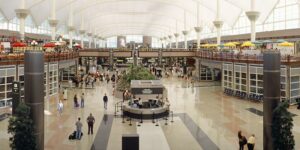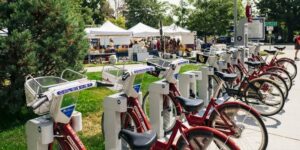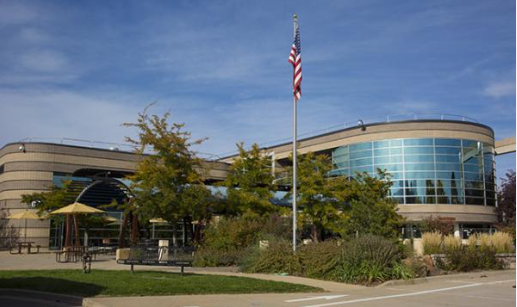NCAR/UCAR – Center Green Campus
CG1 Building
3080 Center Green Drive, Boulder, CO 80301
Arriving by air
 Denver International Airport (DIA) is 42 miles away, served by 25 airlines and with approximately 160 daily nonstop flights from major U.S. cities.
Denver International Airport (DIA) is 42 miles away, served by 25 airlines and with approximately 160 daily nonstop flights from major U.S. cities.
Driving to Boulder from DIA
- Without Tolls: Take Peña Boulevard and merge onto I-70 west. Take I-70 to I-270 west. Continue onto Highway 36, which will take you to the east side of Boulder. This route is free of tolls and takes about 45 minutes during non-peak traffic hours.
- With Tolls: From Peña Boulevard, take the toll road exit north (E-470 north to the Northwest Parkway toward Hwy. 36 West/Denver Boulder Turnpike). Exit onto Hwy. 36 and continue west into Boulder. Please be aware this route has tolls, and if you are renting a car, you will need to make arrangements with your rental car agency.
Shuttle services
- Eight Black Airport Shuttle is a reliable provider, delivering guests directly to many of Boulder’s hotels or other locations. Rates, schedules and details are available on the Eight Black website.
- Boulder Transport provides luxury limousine, airport, and contract transportation services in Boulder, Colorado.
Public bus
You can take the Regional Transportation District (RTD) bus from DIA to Boulder (Route AB). The route makes several convenient stops in Boulder. Buses leave approximately every 60 minutes from the airport. The schedule and route information can be found on RTD’s website (select Route AB/AB1/AB2). Tickets are paid directly to the driver upon boarding the bus. You’ll need cash and exact fare only, as drivers cannot make changes. This is an economical option, with one-way tickets costing $10.50. RTD has an information booth on the baggage claim level of the Main Terminal. The trip takes approximately 80 minutes. www.rtd-denver.com.
Uber now has a partnership with RTD (which runs the public buses). You can use the Uber app to plan your route and pay for your bus fare. Just open your Uber app, choose your destination and starting location, and hit “Transit” among the product options.
The closest hotel to the venue is Residence Inn by Marriott which is just a 1 minute walk away.
Hyatt Place Boulder/Pearl Street is a 15 minute walk, with other hotels at least 30 minutes’ walk away.
Millennium Harvest House Boulder is a more budget-conscious option, and is 40 minutes walk, a 30 minute bus ride, or 10 minutes by car.
Hotel(s) offering a special group rate:
- Residence Inn Boulder (3030 Center Green Drive) for 199 USD per night. Last day to book is 25 September 2022. To take advantage of this special rate, please use this reservation link.
- Courtyard Boulder (4710 Pearl East Circle Boulder) for 209 USD per night. Last day to book is 3 October 2022. To take advantage of this special rate, please use this reservation link.
- Hilton Garden Inn Boulder (2701 Canyon Boulevard) for 169 USD per night. Last day to book is 27 September 2022. To take advantage of this special rate, please use this reservation link.
Public transport in Boulder
 Boulder’s compact downtown is very walkable, and you may find you’re able to easily walk from the venue to your accommodation and nearby eateries. Public bike-sharing kiosks, called B-Cycle are located throughout Boulder and make it fun and easy to pedal from station to station at an affordable rate. Boulder’s in-city bus routes (named the Hop, Skip and Jump) offer another way for attendees to get around town.
Boulder’s compact downtown is very walkable, and you may find you’re able to easily walk from the venue to your accommodation and nearby eateries. Public bike-sharing kiosks, called B-Cycle are located throughout Boulder and make it fun and easy to pedal from station to station at an affordable rate. Boulder’s in-city bus routes (named the Hop, Skip and Jump) offer another way for attendees to get around town.
The regional bus system, Regional Transportation District (RTD), can also help attendees travel throughout the entire city and to nearby towns and Denver. The downtown bus station at 14th and Walnut is a convenient hub for getting around town, to nearby towns, and to and from the airport via Route AB.
Altitude sickness
Boulder is at an altitude of 5,400 ft, so some people may experience altitude sickness. Drink plenty of water, as you will be losing more water than normal in the water vapour you breathe out. For more advice about preventing and dealing with altitude sickness, click here.
Last updated: 18 July 2022
Non-U.S. citizens entering the United States
- If you are a non-U.S. citizen who is a non-immigrant (not a U.S. citizen, U.S. national, lawful permanent resident, or traveling to the United States on an immigrant visa), you will need to show proof of being fully vaccinated against COVID-19 before you travel by air to the United States from a foreign country.
- Non-U.S. travellers seeking to enter the United States via land ports of entry and ferry terminals at the U.S.-Mexico and U.S.-Canada borders are required to be fully vaccinated against COVID-19 and provide proof of vaccination upon request.
- You are considered fully vaccinated:
- 2 weeks (14 days) after your dose of an accepted single-dose vaccine
- 2 weeks (14 days) after your second dose of an accepted 2-dose series
- 2 weeks (14 days) after you received the full series of an accepted COVID-19 vaccine (not placebo) in a clinical trial
- 2 weeks (14 days) after you received 2 doses of any “mix-and-match” combination of accepted COVID-19 vaccines administered at least 17 days apart
If you don’t meet these requirements, you are NOT considered fully vaccinated. A booster dose is not needed to meet this requirement.
A person who has received only one dose of an accepted 2-dose series and has recovered from COVID-19 does not meet this definition, and therefore is NOT considered fully vaccinated for travel to the United States.
- For details of accepted COVID-19 vaccinations and acceptable proof of COVID-19 vaccination, click here.
- Only limited exceptions to the above vaccination requirements apply, and exceptions may need to self-quarantine for 5 days upon arrival. For details, click here.
- All air passengers to the United States will also be required to provide contact information to airlines before boarding flights to the United States. This strengthens a travel process already in place to rapidly identify and contact people in the U.S. who may have been exposed to a communicable disease, such as COVID-19.
- As of 12:01AM ET on June 12, 2022, CDC no longer requires air passengers traveling from a foreign country to the United States to show a negative COVID-19 viral test or documentation of recovery from COVID-19 before they board their flight.
- Remember to also check the requirements of any countries you are transiting through, if applicable, and the entry requirements of the country you are returning to at the end of your trip. Some countries may also have rules about what you need to do to leave the country to travel to abroad, and you should check travel advice for the country you are travelling from.
- Remember to also check your airline’s travel requirements, such as wearing masks.
Colorado’s state-wide mask laws
In Colorado, Public Health Order 20-38 requires people to wear masks in certain settings, as follows:
- Health care settings. These include any facility, office, clinic, or other location where medical services are provided, including hospitals, ambulatory surgical centers, freestanding emergency departments, urgent care centers, clinics (including medical clinics or services in nonmedical congregate settings), doctors’ offices, and non-urgent medical care structures. Masks in health care settings are required when COVID-19 Community Transmission levels are substantial to high according to CDC’s COVID Data Tracker. Patients and visitors can wear any type of mask when masks are required.
- Non-medical congregate settings serving at-risk populations. These include homeless shelters, prisons, jails, community corrections, substance abuse and day treatment programs, and adult day centers and day programs. Masks are required for participants and visitors, and medical grade masks or respirators are required for staff, when COVID-19 levels are medium or high according to CDC’s COVID-19 Community Levels.
It is no longer a requirement to wear a mask on public transport in the USA, but it is still recommended by the CDC (Centers for Disease Control and Prevention) to wear masks in indoor public transportation settings.
